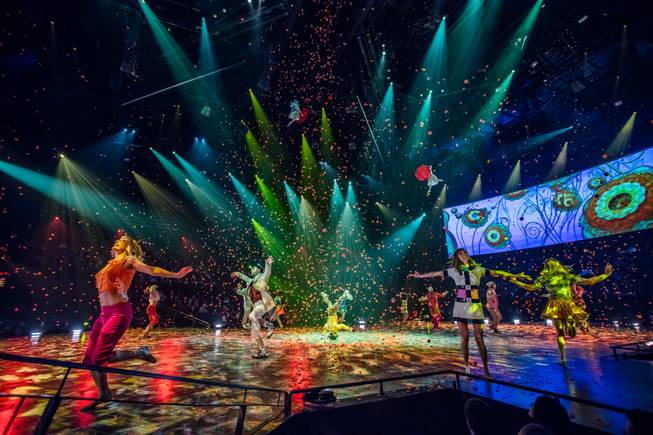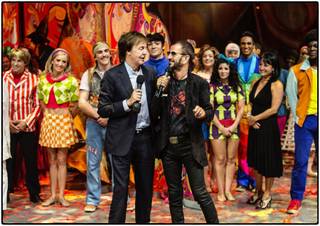
Matt Beard
The cast performs during “The Beatles Love by Cirque du Soleil” show at the Mirage, July 14, 2016 in Las Vegas.
Tuesday, Aug. 2, 2016 | 2 a.m.
When asked about the possibility of a Beatles reunion, John Lennon sometimes demurred by evoking what he considered the most depressing prospect facing rock musicians who cling to stardom too long: “Going to Vegas and singing your great hits,” as he put it in an interview shortly before his death in 1980.
A quarter-century later, the Beatles made their way to Vegas, but in a far more creative way. In collaboration with Cirque du Soleil, the Canadian producer of spectacles, Apple Corps, the Beatles’ production company, created “Love,” a kinetic theater piece set to 90 minutes of quirkily remixed Beatles music, staged in a purpose-built theater at the Mirage.
The Beatles, it turned out, could have a Las Vegas run without donning a single sequined tuxedo, and with their reputation for sidestepping expectations — even Lennon’s — intact.
When “Love” opened, in 2006, some critics raised an eyebrow at the prediction by Apple and Cirque that it would run for 10 years. How many Beatles fans, after all, were likely to travel to Las Vegas to see a site-specific acrobatic show?
A great many, it turns out. Just after the 10th anniversary performance, on July 14, a Cirque spokeswoman provided an answer: Since 2006, nearly 8 million people had seen “Love.”
The anniversary show — attended by Paul McCartney, Ringo Starr and Yoko Ono — introduced a significantly revamped version of “Love.” Dominic Champagne tweaked his script to give it a more coherent narrative arc. The choreography was overhauled, as were the Day-Glo, pop art costumes. Both the stage technology and sound system (including more than 6,000 speakers, which had about 7,500 hours on them) were upgraded. And the show’s soundtrack has been remixed, with a few substitutions.
That soundtrack is a significant part of the show’s attraction. It does not present the music straight: George Martin, the band’s producer (who died in March), and his son Giles, who has since overseen several Beatles archival projects, combed through the Beatles’ session masters and created mash-ups, blending elements from several songs — the drums and tape loops from “Tomorrow Never Knows” and the sitar, tabla, orchestra and vocals from “Within You, Without You,” for example — to give the group’s familiar tunes fresh twists. And they mined the tapes for amusing bits of between-takes studio chatter, which are sprinkled throughout the show.
But virtually all the music was included in the 2006 CD release, the deluxe edition of which included a 5.1 surround disc. So the show’s durability clearly has as much to do with Cirque’s contributions, which are impressive both as physical theater and as storytelling.
“The first thing is that the music was adapted so effectively,” said John Katsilometes, a columnist who covers entertainment for The Las Vegas Sun and Las Vegas Weekly. “But also, the Beatles’ career arc, and the evolution of their music and their image, fits very well with Cirque. Cirque can do the imagery of sound very well, and they were able to match the Beatles’ artistic sensibility in a way that hasn’t worked as well with other artists. They really struggled, for example, when they tried to fit their sensibility with Elvis. With the Beatles, it feels right.”
To an extent, the show is a tongue-in-cheek fantasy version of the Beatles’ history or, at least, selective glimpses of it. As the show begins, to the unaccompanied harmony vocals of “Because,” and a mash-up of “Get Back” and “Glass Onion,” Cirque’s staging and projections suggest Liverpool’s privations during World War II, when the Beatles were born, and just after. Yet instead of Nazi bombers, we see Blue Meanies, the villains from the “Yellow Submarine” cartoon film.
But however much “Love” outlines the Beatles’ career, or amplifies their comments and philosophy (“All You Need Is Love” is the finale), it is no one’s idea of a documentary. Artistic license allows Champagne to conflate the auto accident described in the first verse of “A Day in the Life” with not only the death of Lennon’s mother, Julia, who was run over while crossing the street, but also with the consolation that McCartney offered to Lennon’s older son, Julian, upon his parents’ breakup, in “Hey Jude.”
In a way, “Love” has helped make Lennon’s notion of Las Vegas obsolete. Mick Jagger and Alice Cooper have stopped in to see it; Steven Tyler of Aerosmith has seen it five times. But the transformation of Las Vegas’ image, Katsilometes said, was underway before “Love” opened, as upgraded theaters have attracted stars at the peaks of their careers, as well as rockers like The Who and John Fogerty, who bypassed the city in the 1960s. (The Beatles actually played two concerts at the Las Vegas Convention Center on Aug. 20, 1964, and McCartney and Starr often have tour stops there now.)
“Las Vegas has become a place where established artists who still have a great deal of commercial appeal can come and play mini-residencies,” Katsilometes said of the city’s musical regeneration. He cited Fogerty, who lately has come to Las Vegas twice a year to play eight or nine shows in 15 days. “These are acts that have name recognition, multigenerational appeal, and can fill a 90-minute set with familiar songs. Diana Ross, Jennifer Lopez, Britney Spears — even at a young age — Celine Dion, Rod Stewart and Elton John all fit that description.”
For Beatles obsessives, the show has turned the Mirage into a bona fide pilgrimage site — the only place in the world you can see a Beatles-approved theatrical production with an enveloping surround soundtrack, direct from the master tapes.
A spokeswoman for Apple said that there were no plans for a successor to “Love,” but that the continuing demand for the production suggests that fans would come back for more. There is still plenty of material to draw on — “Love” presents only about a tenth of the Beatles’ songbook, and by allowing mash-ups, Apple has made endless variation possible.
And, in the end, “Love” is a measure of how the Beatles’ music continues to speak to new listeners, and how the group’s constituency has continued to expand: The show’s audience of 8 million is vastly larger than the number of people who saw the Beatles perform live. And its 10-year run is even longer than the group’s recording career.


Join the Discussion:
Check this out for a full explanation of our conversion to the LiveFyre commenting system and instructions on how to sign up for an account.
Full comments policy